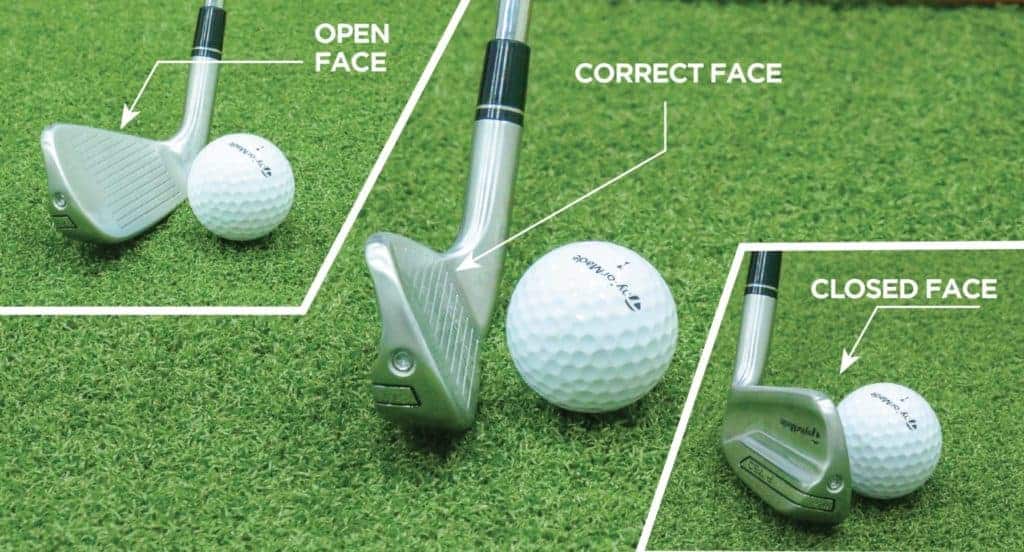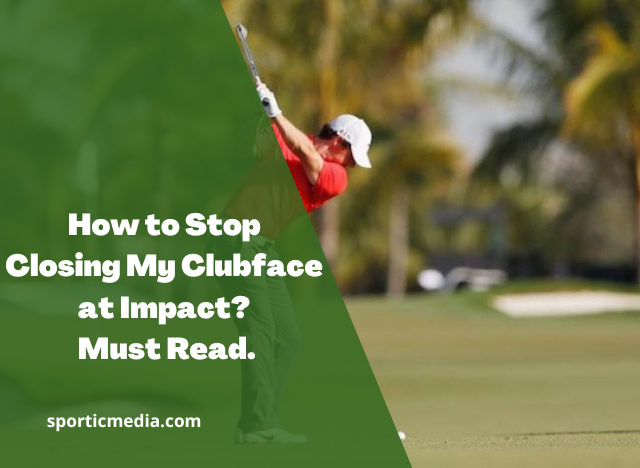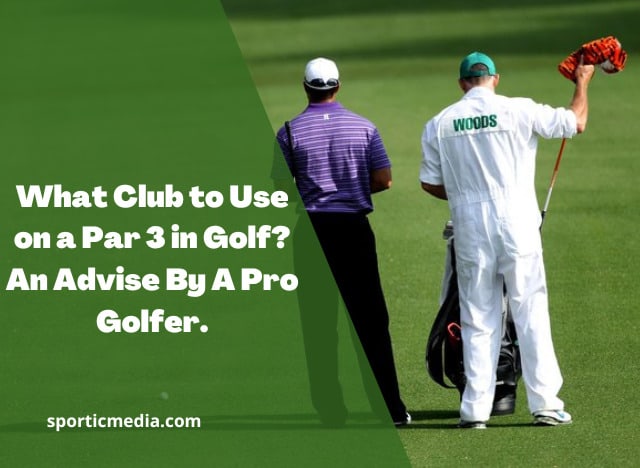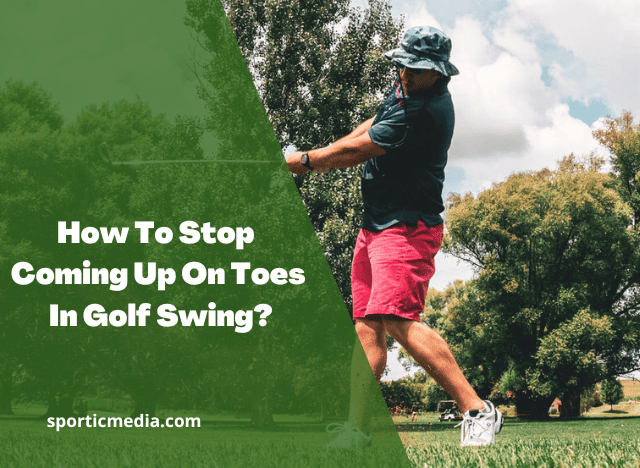Should I close my clubface at impact? If you hit a slice, you may be wondering why your club closes its face at the address. A closed club face causes your ball to start out left. It may also cause you to hit a slice. This issue affects all aspects of your golf swing. If you want to improve your game and reduce your slices, you should learn how to stop closing your club face at impact.
In this article, we discuss almost everything you need to know about closing the clubface at impact, and we invite you to stick around until the end to find out what you’ve been looking for. Welcome to Sportic Media, where we discuss the best points to improve your golf in a short time.
How to Stop Closing My Clubface at Impact
Table of Contents
Should Club Face be closed at impact?

Some golf instructors promote the closed clubface at impact and recommend that you close it on the top of the backswing. However, this theory is vastly oversimplified and without evidence.
Watching a YouTube video can help you determine if the closed clubface at impact theory is true for you. However, you should not make any drastic changes to your swing right away. You should gradually work on implementing the closed clubface angle.
A closed clubface at impact is an incorrect golf swing technique. It causes unintended draw and slice shots and causes torque on the arms and wrists.
It can also result in inaccuracies in your swing and may require the use of a loft adjustment to compensate for the lack of ball flight control. There are two main ways to swing a golf club – a closed or open clubface position.
How open should your club face be?
Before taking your grip and rotating the club gently to 1 o’clock, a square club face has the toe pointing up to 12 o’clock on a clock face (11 for left handers). Correctly hold the club only after you’ve completed it. Don’t go overboard. After that, set your stance and aim the club face at your target.
How should the clubface look at impact?
The following YouTube video will help you to learn how should the clubface should look at impact and some other very important things to improve your strengths to play better golf.
Does a closed club face cause a pull?
A closed clubface at impact is one of the things that can produce a pull. With a clubface that is either open or closed at impact, you will never be able to hit the ball straight, no matter how wonderful your alignment. Your torso may perhaps not be in proper alignment.
How To Get Sticker Residue Off Golf Shaft? Best Guide Ever
sportic media
Why does my club’s face close at impact?
There are two main reasons why your club’s face closes at impact. The most common is a breakdown in your wrist action.
This can be magnified by your setup, swing path, and follow-through. One way to correct this is to start with a square clubface at setup. This way, you’ll carry the closed face angle through your swing. The other reason is that your swing path is sloppy.
Your swing technique is likely the culprit. You’ve been taught by your golf instructor that you should use the larger muscles to swing the club.
But when you’re using the smaller ones, your wrist action is likely to lag at impact and cause an open clubface. This can result in a low-line drive hook shot. In such cases, you’ll need to work on the way you grip the club.
Why is my clubface closed at the address?
A closed clubface at the address position will cause your shot to start left. As a result, your ball will start left of the line you’re aiming for. As a result, you’ll probably end up with a slight pull fade all day long.
Regardless of the cause of your closed clubface at the address position, there are simple adjustments that you can make to get your ball flying right.
Golf fitness instructor Tyler Ferrell has been named one of Golf Digest’s “Best Young Teachers” and “Best Golf Fitness Professionals” in America.
If you’ve ever wondered why your clubface is closed at the address, check out his show “The Golf Fix,” which airs Mondays at 7 p.m. ET. It’s free and has been viewed by millions of people. His methods have helped countless golfers improve their game.
Should Club Face be closed at the address?
How to Stop Closing the Clubface at Impact?
Here’s a straightforward guide to help you understand what causes a closed clubface and how to fix it in simple terms.
What Causes the Clubface to Close at Impact?
01. Weak Grip
Your grip on the club matters. If your left hand is turned too much counterclockwise (a “weak” grip), it can lead to a closed clubface at impact.
To check, make sure the “V” formed by your left thumb and forefinger points at your belt buckle. If it’s off to the left, your grip may be too weak.
02. Swing Path
The path the club takes as it approaches the ball is crucial. An “out-to-in” swing path, where the clubhead comes from the outside, can cause a closed clubface.
The ideal path is slightly “in-to-out.” To check your path, use chalk on the back of your clubhead and see where it points after a swing.
03. Rolling Wrists
Letting your wrists roll over too much at impact can close the clubface. Keep your wrists firm to maintain a square clubface through the ball.
Imagine the back of your left hand pointing at the target throughout the swing.
04. Body Rotation
If your body doesn’t rotate through impact, your arms and hands must do all the work, which can lead to a closed clubface. Engage your core and ensure your hips and shoulders rotate through impact.
How to fix it?
- Correct Your Grip: Ensure you have a square grip by checking the “V” formed by your thumb and forefinger on your left hand. It should point at your belt buckle. Adjust as needed.
- Check Your Swing Path: Use chalk on your clubhead to see if your swing path is correct. Try for a slightly in-to-out path.
- Maintain Firm Wrists: Keep your wrists from rolling over too much by practicing with your hands in a “prayer position.” This helps develop the feeling of maintaining firm wrists.
- Rotate Your Body: Make sure your body rotates through impact. Place a ball behind your right heel and practice rotating your body to hit the ball.
Drills to Help You Improve
Here are a few drills that can help you stop closing the clubface at impact:
- Alignment Drill: Use an alignment stick and ensure the ball stays in line with it during your swing to develop an in-to-out swing path.
- Draw Drill: Work on hitting draws, which require a slightly closed clubface at address and an in-to-out swing path.
- Towel Drill: Place a towel behind the ball and aim to brush it with your clubhead during your swing to maintain firm wrists and body rotation.
Tips for Improvement
- Practice Regularly: Muscle memory is key. The more you practice, the easier it becomes to maintain a square clubface.
- Be Patient: Changing habits takes time, so don’t get discouraged if you don’t see immediate results. Keep practicing.
- Get Professional Help: If you’re still struggling, consider taking a lesson from a qualified golf instructor who can pinpoint your swing issues and provide tailored drills.
Remember, fixing a closed clubface at impact can greatly improve your golf game, helping you hit straighter and more accurate shots. With practice and the right techniques, you can make this adjustment and enjoy a more satisfying golf experience.
Can a closed club face cause a slice?
Is a closed club face a contributing factor to a slice? For golfers who struggle with a slice, it is very important to check the grip. It is important to keep the clubface open, otherwise you will end up with a pull. If your grip is too tight, it can also contribute to a slice. However, if you strengthen your grip, this issue will disappear.
If your grip is too loose, the clubface will open at impact, which adds side spin to the ball. In turn, this causes the ball to curve to the right, creating a slice. The key is to grip the clubface squarely, which will fix the issue.
In order to do so, rotate your hands at the bottom of your swing. Doing so will also enable you to see your top three knuckles on your non-dominant hand.
Another key to preventing a slice is to avoid gripping too tightly with your dominant hand. Also, if you grip the clubface too tightly, it will hinder your natural tendency to square the clubface at impact.
Best Club to Tee Off with for Beginners; The Best Guide For Beginners
sportic media
Do you open club face to hit a draw?
How do you hit a club face in draw?
The first step in hitting a draw is to pick the right target. A draw is not the same as a fade. A draw is an arcing shot that carries farther and requires a closed club face at impact. The setup for a draw is exactly the opposite of a fade, so if you’re left handed, you should adjust your setup to make it a draw.
A draw is a shot in which you aim for the right of your target. By aiming for the right, you can make your ball start out to the right and curl back towards the target line.
You must perform additional actions to achieve this shot, such as aligning your body and feet to the right. Using a draw drill to practice this shot will help you understand your alignment and feel the proper angle at impact.
How To Remove Ping G425 Driver Head? Step By Step Guide
sportic media
Some related FAQs.
Why is my club face closed at the top?
When the clubface is angled more upward at the top of the swing, it is said to have a closed face. Creating a slightly closed clubface posture at the top of the swing is frequently the first step in correcting one or all of the three swing problems mentioned above.
Do draws go further than fades?
“A draw and a fade will roll and carry the same distance if the ball speed, launch angle, and spin rate are all the same. Practically speaking, though, most club golfers will hit a draw farther than a fade because hitting a draw lowers the loft and lowers spin rates.
How many yards does a draw add?
Many PGA Tour players prefer striking a draw, while some professionals play the power cut as their go-to stroke. So why is learning how to strike a draw necessary? The first is that, depending on the speed of the fairways, hitting a draw, particularly with your driver, can add 5–15 yards of distance.
Discover the meticulous and expert-driven process behind our product reviews at Sportic Media. Our comprehensive guide, led by industry veterans, ensures you get the most reliable and detailed insights into golf equipment. Dive into our methodical approach by visiting How We Test Products at Sportic Media: A Comprehensive Guide
.







